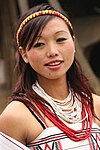Khiamniungan people
[3] The origin of the Khiamniungans remains uncertain but the earliest consideration that generally traces back to a place called Khiamnyunga.[5] During the British Raj, the Khiamniungans were referred to as "kalyo Kenyu", particularly in the works of anthropologists such as Christoph von Fürer-Haimendorf.Unlike several other Naga people, the advent of Christianity had little impact on the Khiamniungan for a long time, due to their remote location.[10] The Khiamniungan people, who traditionally practised jhum cultivation (slash and burn agriculture), celebrate the Miu festival at the time of sowing.Traditionally it was played between villages in the form of competition unlike today's norm of performing for entertainment purposes.




Naga woman
Patsho KhiamniunganKhiamniungan languageChristianityAnimismNaga peopleethnic groupNoklak DistrictNortheast IndianNagalandNaga Self-Administered ZoneHkamti DistrictMyanmarBritish RajKhiamnyungaLingnyuTshüvauPatsho RangePatshoNoklakChristoph von Fürer-Haimendorfpriestdoctororaclecowriesconch shellsNütsahtraditionalKhiamniunganssocial rankingcowrie shellsgourdsbamboo flutesjhum cultivationTsoukumharvest festivalAngamiChakhesangChotheKharamKonyakLainongLamkangLiangmaiMakuryMaringMonsangPochuryPoumaiRengmaRongmeiSangtamTangkhulTangsaThangalTikhirWanchoYimkhiungHill tribes of Northeast IndiaMizoramChakmaDimasa (Kachari)HajongKhasi and JaintiaSynteng or PnarLyngngamKuki TribesMan (Tai speaking)Mizo (Lushai) tribesMikir (Karbi)Naga tribesPawi (Lai)Synteng (Pnar)YimkhiungNagaBodo-KachariMeghalayaKhasi Synteng or PnarLakher (Mara)Arunachal PradeshAbor (Galo)Aka (Hruso)ApataniDafla (Nyishi)GalongKhowa (Bugun)MishmiMiju MishmiChugpaLishipaSherdukpenSingpho (Jingpo)Tai peoplesKhamptiKhamyangKhambaMinyongMishing (Miri)PuroikZekhringManipurGangteKoirao (Thangal)KoirengSuhte (Paite)ThadouVaipheiTripuraBhutiaJamatiaKhasiaLepchaLushai (Mizo)Munda, KaurNoatiaSantalTripuriSikkimSherpaTibetanHrangkhwal, RangkholKhelmaSairhem TangsaList of Scheduled Tribes in India